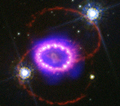Speaker
F. Thielemann
(Dept. of Physics, University of Basel)
Description
Supernovae are observationally characterized by their lightcurves, spectra,
late time radioactivities in remnants and their integrated contribution to
chemical evolution, witnessed in observations of old stars. We will highlight
open questions with respect to nucleosynthesis contributions from core collapse
supernovae. While many aspects of intermediate mass (alpha) elements are
understood with present supernova models, where the nucleosynthesis calculations are
still based on induced explosion mechanisms, the composition of the innermost ejecta
depends on a self-consistent treatment of the explosion. This relates to nuclei of
the Fe-group, the so-called LEPP nuclei up to Sr-Y-Zr, the understanding of a
νp-process, and the options for a weak and/or strong r-process.
We will discuss these aspects with respect to presently existing supernova models and
recent investigations in stellar evolution with rotation and s-process contributions
from massive stars, specific equations of state which permit explosions via the
quark-hadron phase transition, as well as core collaspe events with rotation and
strong magnetic fields.
Primary author
F. Thielemann
(Dept. of Physics, University of Basel)

